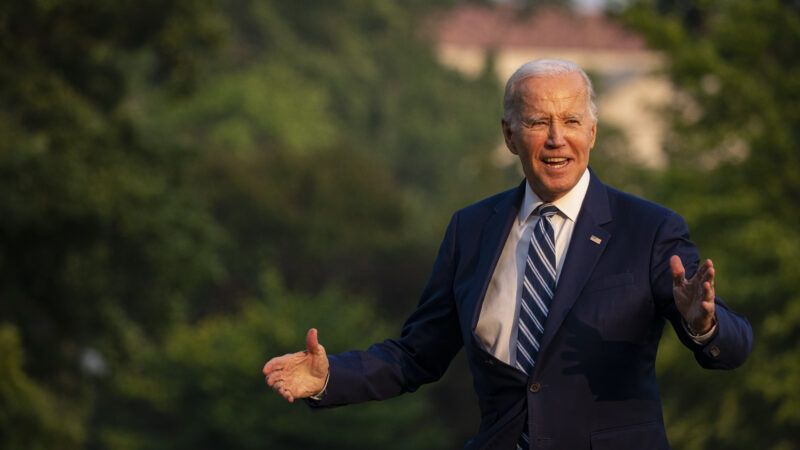'Bidenomics' Is Nothing New
It's a familiar program. And it will result in higher prices, slower growth, and fewer jobs.

Politics is sometimes little more than marketing. As evidence, behold the sudden use of the term "Bidenomics" by Democrats to describe administration policies of the past few years. Indeed, what's being branded as "new" is nothing but the same old program of big spending, big regulations, and big cronyism. The only difference is that it's on a much bigger scale.
The administration will need all the marketing it can get to sell these ideas, especially to a public that's been giving it approval ratings in the thirties. But no marketing effort should distract us from the economic realities of the past two years.
Begin with Bidenomics' hallmark: record spending. The president likes to claim he's cut the deficit, but his allies in a unified Democratic congress have enacted $5 trillion in new spending over the decade. In an old-fashioned move, they have put most of it on Uncle Sam's credit card rather than engaging in the politically unpopular move of paying with new taxes and spending offsets. As a result, annual budget deficits will grow over the next 10 years to around $3 trillion. For perspective, remember that just before the pandemic, the annual deficit was around $1 trillion.
This is no partisan argument. Looking at the spending trajectories under different presidents and Congresses, one realizes that this has been going on for a long time. Each administration and Congress irresponsibly outspends its predecessors, and each kicks the can down the road for future generations to deal with. This includes Republican presidents like Donald Trump and George W. Bush. Yet, this president took it to another level with an over-the-top embrace of the fiscal irresponsibility of the $2 trillion American Rescue Plan, which turned modest post-pandemic inflation into a 40-year inflation record.
If Bidenomics is about building up the middle class—as the president claims—it isn't cutting it. Since 2021, real wages have fallen every month. Unsurprisingly, the fight against inflation has raised interest rates and mortgage rates, putting pressure on millions of household budgets.
And while Bidenomics has allegedly created some 13.4 million new jobs, this number should be taken with a grain of salt. Most are what David Stockman, one of former President Ronald Reagan's budget directors, calls "born again jobs." That's because they aren't actually new—they are simply the product of reopening the economy after the terrible COVID-19 lockdowns. Many of the remaining jobs were created by the same inflationary infusion of cash that overheated the economy. This is nothing to brag about.
While few people (other than rabid ideologues) deny that most of the inflation surge was created by Biden and Congress' extravagant spending, some of it was the result of a continued comfort with constraining the available supply of goods and services. Take, for instance, the administration's early support for COVID-19 lockdowns and mandates coupled with its refusal to remove the Trump-era tariffs that were helping to keep prices elevated.
Further contributing to high prices is Biden's reversal of Trump's productive regulatory reforms and imposition of additional regulations. These include new environmental standards along with additional restrictions on the supply of energy and health care.
A Hoover Institution study of Bidenomics looked at the impact of taxes, regulations, and spending. The authors found that "in the long run, Biden's full agenda would reduce full time equivalent employment per person by 3 percent, the capital stock per person by about 15 percent, real GDP per capita by more than 8 percent, and real consumption per household by 7 percent." Meanwhile, the failure to reform immigration and address the crisis at the border deprives the labor market and employers of the additional workers they need to produce more.
There is one area, however, where Bidenomics has been extremely successful: favoritism. The administration's industrial policy has aggressively subsidized preferred industries such as semiconductors and electric cars, sheltered special interests from the accountability of consumers through mandates and bans, and boosted the fortunes of its union friends. Most of this took place under the cover of reviving the manufacturing sector and making long-term investments in sectors vital to our national well-being—and, of course, competing with China. As The Wall Street Journal's Andy Kessler noted, "All that's missing from his 'new Washington consensus' is Soviet-style Five Year Plans."
Bidenomics will make a few fat cats happy, but the result will be higher prices, slower growth, and fewer jobs. The rest of us will be left with a sour taste in our mouths, slimmer pocketbooks, and heightened worries for the future.
COPYRIGHT 2023 CREATORS.COM.

Show Comments (84)